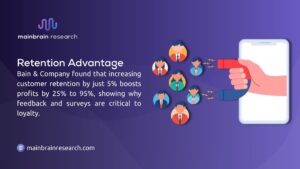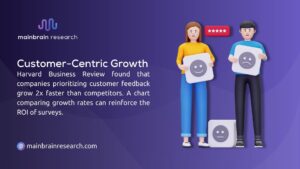Every day, businesses make expensive mistakes. A restaurant changes its menu without asking customers what they want. A software company builds features nobody needs. A retailer stocks products that sit on shelves for months.
These failures share a commonality – they could have been prevented. How? By simply asking people what they think before making big decisions.
Market research surveys can help you avoid these mistakes. But what is a market research survey exactly? Think of it as a conversation with your customers, except you’re talking to hundreds or thousands of them at once. Instead of guessing what people want, you ask them directly.
Businesses that regularly survey their customers grow 23% faster than those that don’t. Meanwhile, 72% of failed product launches could have been avoided with proper market research. Yet many business owners still rely on gut feelings rather than hard data.
What are Market Surveys?
You have questions about your business. Your customers have answers. Surveys connect the two.
Maybe you’re wondering if customers would pay more for premium features. Or which marketing message resonates best. Or why people choose competitors instead of you. A well-designed survey can answer these questions in a few weeks.
The magic happens when businesses stop assuming and start asking. The importance of market research becomes clear when you see how often business assumptions are wrong.
Consider what happened to a small bakery in Portland. The owner spent months perfecting a new line of gluten-free pastries, convinced there was huge demand. After launching, sales were terrible. A simple survey would have revealed that most of their customers actually wanted more coffee varieties, not gluten-free options. That mistake cost $15,000 in wasted ingredients and lost time.
Different Types of Surveys for Different Needs
Not every survey serves the same purpose. Smart businesses choose the right type based on what they need to learn.
Some surveys collect numbers – how many customers are satisfied, what percentage would buy a new product, which features matter most. These quantitative surveys work great for measuring things and making predictions.
Other surveys gather stories and explanations. They ask why customers make certain choices, how they feel about different options, what problems they’re trying to solve. These qualitative surveys reveal the thinking behind customer behavior.
The smartest approach uses both types. Numbers show what’s happening, while stories explain why it’s happening.
Primary vs Secondary Research
Primary research means collecting fresh information directly from people. You design the survey, choose the audience, and get answers to your specific questions. It takes more work but gives you exactly what you need.
Secondary research uses existing data from industry reports, government statistics, or previous studies. It’s faster and cheaper but might not address your particular situation.
Most successful research combines both. Secondary research provides background context, while primary surveys deliver targeted insights for specific business decisions.
Common Survey Types Every Business Should Know
Different business situations call for different survey approaches. Here are the main types:
| Survey Type | Purpose | Best Used For |
| Customer Satisfaction | Measure happiness with service | Regular check-ups on performance |
| Product Testing | Get feedback on new ideas | Before launching new products |
| Brand Perception | Understand how people see your brand | Planning marketing campaigns |
| Market Research | Size up opportunities | Entering new markets |
| Competitor Analysis | See how you stack up | Positioning against rivals |
Customer Satisfaction Surveys
These surveys check whether customers are happy with their experience. The key is asking specific questions rather than generic “how satisfied are you” queries.
Better questions focus on particular interactions: “How easy was it to find what you needed on our website?” or “Did our support team resolve your issue quickly?” Specific questions lead to actionable improvements.
Send satisfaction surveys soon after customers interact with your business, while the experience is fresh in their minds.
Product Development Surveys
Testing product concepts before investing in development can save enormous amounts of money. These surveys help identify problems early, when they’re cheap to fix.
A small tech startup saved $200,000 by surveying potential customers before building their app. The survey revealed that their original concept solved a problem most people didn’t have. They pivoted to address a real need and launched successfully six months later.
Product surveys work best when they show realistic concepts rather than abstract ideas. Screenshots, mockups, or detailed descriptions help people give meaningful feedback.
Competitive Analysis Surveys
Knowing how customers choose between different options reveals important strategic insights. These surveys often uncover surprising information about the competitors.
One restaurant owner discovered through surveys that his main competition wasn’t other restaurants – it was grocery stores. Busy families often chose to cook at home rather than dine out. This insight led him to offer family meal packages for pickup, which became his most profitable service.
The Financial Benefits of Survey Research
Market research surveys cost money upfront but typically pay for themselves many times over through better decisions and avoided mistakes.
Companies using survey insights in their email marketing see returns of $38 for every dollar spent. Businesses that regularly survey customers report 35% higher customer retention than those that don’t.
The ROI often comes from prevented disasters rather than direct revenue increases. A $3,000 survey that prevents a $100,000 product failure delivers incredible returns.
How to Calculate Survey ROI
Measuring survey returns can be tricky because benefits often come from avoided problems. However, several factors contribute to measurable value:
- Risk Prevention: Surveys help avoid expensive mistakes in product development, marketing, and strategic decisions. Research costs typically represent a tiny fraction of potential losses from bad choices.
- Improved Targeting: Knowing your customer preferences leads to more effective marketing and product development. Companies report 20-45% improvements in conversion rates after implementing survey insights.
- Customer Retention: Satisfaction surveys identify problems before customers leave. Keeping existing customers costs far less than finding new ones.
- Market Opportunities: Surveys reveal unmet customer needs that competitors might be missing. These insights can lead to new revenue streams.
Creating Surveys That Bring Results
The difference between useful surveys and worthless ones often comes down to design and preparation. Good surveys produce reliable insights that inform business decisions. Bad surveys waste time and provide misleading information.
Start With Clear Goals
Vague objectives produce vague results. Instead of “learn about customer preferences,” effective surveys target specific questions like “determine which three product features customers value most when choosing between options.”
Clear goals guide every survey decision—whether to include specific questions, whom to survey, and how to analyze responses.
Choose the Right People
Surveying the wrong audience leads to unreliable data that can mislead business decisions. The people you survey should match the business question you’re asking.
For customer satisfaction research, this means reaching actual customers who’ve recently interacted with your business. For new product concepts, it means finding people who represent your target market.
Too few responses provide unreliable results, while oversized samples waste money without improving accuracy proportionally.
Write Better Questions
Question quality directly impacts answer quality. Well-designed survey questions follow several key principles:
- Use simple language: Avoid jargon, technical terms, or complex concepts that might confuse respondents. Write questions the way you’d ask them in normal conversation.
- Stay neutral: Leading questions push people toward particular answers and skew results. Good questions let respondents express their true opinions.
- Be specific: Ask about particular experiences or situations rather than general impressions. “How satisfied were you with your last purchase?” works better than “How do you feel about our company?”
- Stay relevant: Every question should serve your research goals. Interesting but irrelevant questions waste respondent time and reduce completion rates.
Testing questions with a small group before launching the full survey helps catch potential problems and improve response quality. The best market research questions balance specificity with neutrality while remaining easy for target audiences to understand.
Survey Methods and Distribution
Different survey methods work better for different situations and research objectives.
Online Surveys
Web-based surveys have become the most popular research method because they’re fast, affordable, and scalable. Online platforms can reach thousands of people quickly while providing instant results.
Online surveys work particularly well for quantitative research, customer feedback, and market validation studies. They support various question types including images, videos, and interactive elements.
The main drawbacks are internet access requirements and potential bias toward tech-savvy respondents.
Phone and Face-to-Face Surveys
While more expensive than online methods, phone and in-person surveys often achieve higher response rates and allow for more complex questioning.
These approaches work well for sensitive topics, detailed qualitative research, and reaching people with limited internet access. Personal interaction lets researchers clarify confusing questions and explore responses in greater depth.
Combining Methods for Better Results
Many successful research programs combine different approaches. Focus group market research provides detailed qualitative insights that inform broader survey design. Online surveys then validate focus group findings with larger populations.
This combination maximizes the strengths of each method while providing comprehensive market understanding.
Advanced Survey Techniques
Experienced businesses use sophisticated survey techniques to gain deeper market insights and competitive advantages.
Customer Segmentation
Instead of treating all customers the same, segmentation analysis identifies distinct groups with different needs and behaviors. This enables personalized marketing strategies and targeted product development.
Effective segmentation examines purchasing patterns, demographic characteristics, usage behaviors, and satisfaction drivers to create detailed customer profiles.
Longitudinal Studies
Single surveys provide snapshots of current conditions. Tracking studies monitor changes in customer attitudes, market conditions, and competitive landscapes over time.
Long-term tracking reveals trends that one-time surveys miss and helps businesses understand the impact of strategic changes or market shifts.
Multi-Source Research
Comprehensive market intelligence combines survey data with other information sources like website analytics, social media monitoring, sales data, and customer service records.
This integration provides complete pictures of market conditions and validates survey findings through multiple perspectives.
Common Survey Mistakes to Avoid
Even experienced researchers make errors that compromise survey effectiveness and data quality.
-
Sample Size Problems
Too few responses provide unreliable results that can’t be confidently applied to broader populations. Too many responses waste resources without improving data quality proportionally.
Professional researchers calculate appropriate sample sizes based on population characteristics, desired confidence levels, and acceptable error margins.
-
Question Design Issues
Poorly written questions skew results and provide false validation for preconceived ideas. Common problems include leading questions, confusing language, and questions that try to cover multiple topics simultaneously.
Careful question development involves multiple reviews and testing with representative groups to identify and fix potential issues.
-
Low Response Rate Problems
Poor response rates compromise data quality and can introduce bias when only highly motivated people participate. Successful surveys use multiple strategies to encourage participation:
- Keep surveys reasonably short to respect people’s time
- Clearly explain the survey purpose and how results will be used
- Offer appropriate incentives for participation when possible
- Ensure surveys work well on smartphones and tablets
- Send strategic follow-up reminders without being pushy
-
Analysis and Interpretation Errors
Collecting survey data is only half the job. Proper analysis transforms raw responses into actionable business insights through statistical analysis, trend identification, and strategic interpretation.
Many organizations benefit from professional analytical support to ensure survey investments produce maximum value and reliable conclusions.
Technology Changes in Market Research
Market research continues to evolve with technological advances and changing consumer behaviors.
Digital Improvements
Modern survey platforms use artificial intelligence to analyze responses and identify patterns. These technologies improve data quality while reducing the expertise needed for professional research.
Mobile-friendly survey design has become essential as smartphone usage dominates. Surveys must work effectively across different devices and screen sizes.
Real-Time Insights
Businesses increasingly need immediate market intelligence to respond quickly to competitive changes and emerging opportunities. Real-time survey systems enable continuous feedback collection and instant analysis.
This capability proves especially valuable for customer service improvement, product launch monitoring, and crisis response.
Integration with Business Tools
Modern survey platforms connect directly with customer databases, marketing tools, and business intelligence systems. This integration enables automatic data sharing and comprehensive customer profile development.
Seamless connections between survey insights and operational systems help ensure research findings translate into practical business improvements.
Making Market Research Work for Your Business
Successful survey programs require careful planning, professional execution, and systematic follow-through to achieve desired outcomes. The investment in proper research methodology typically produces returns that far exceed initial costs through better decision-making and reduced business risks.
Smart businesses use survey findings to improve products, refine marketing messages, enhance customer service, and identify new growth opportunities.
MainBrain Research has helped hundreds of companies develop effective market research strategies tailored to their specific needs and goals. Our team creates research programs that provide reliable insights for strategic planning, product development, and market expansion.
We will show you how professional market research transforms business performance and positioning.


















